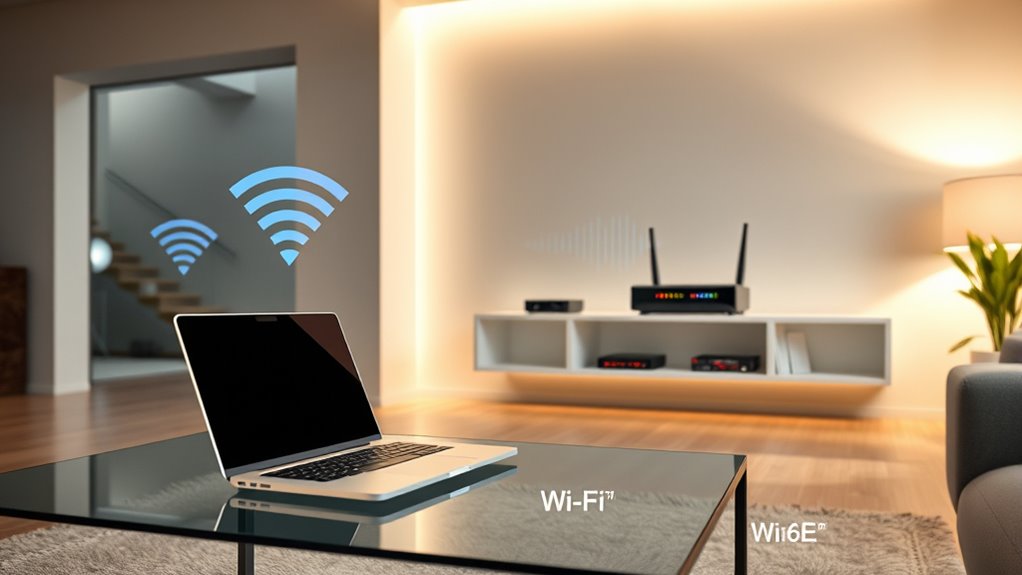Wi-Fi 7 is nearly five times faster than Wi-Fi 6E, offering improved speed, lower latency, and better performance in crowded environments. If your devices support Wi-Fi 6E and your network handles basic streaming or browsing, an upgrade isn’t urgent. However, if you need ultra-fast speeds for gaming, 4K streaming, or smart home connectivity, Wi-Fi 7 could be worth it. To decide, understand how these techs impact your daily use—explore more to find out.
Key Takeaways
- Wi-Fi 7 offers significantly faster speeds and lower latency, ideal for high-demand activities like gaming and 4K/8K streaming.
- Wi-Fi 6E provides substantial improvements over previous standards and is sufficient for most users’ current needs.
- Upgrading to Wi-Fi 7 is beneficial only if your devices are compatible and you require ultra-fast, low-latency connections.
- Wi-Fi 7’s ecosystem is still emerging, so immediate benefits depend on device availability and adoption timeline.
- For most users, Wi-Fi 6E is a cost-effective, high-performance upgrade, while Wi-Fi 7 is more suitable for future-proofing advanced applications.
Speed and Performance Gains

Wi-Fi 7 markedly outperforms Wi-Fi 6E in speed and performance, offering much higher maximum theoretical speeds. While Wi-Fi 6E peaks at 9.6 Gbps, Wi-Fi 7 reaches up to 46 Gbps, almost five times faster. This leap means multi-gigabit speeds for single devices, making data transfers and streaming much quicker. Although real-world speeds will fall below these maxima, Wi-Fi 7 still provides a significant performance boost. The key driver is its advanced Extremely High Throughput (EHT) technology, which enhances overall capacity. These improvements allow you to handle demanding tasks like 4K or 8K streaming, large file transfers, and high-bandwidth applications more smoothly. So, if speed is your priority, Wi-Fi 7 clearly offers a noticeable upgrade over Wi-Fi 6E. Enhanced capacity also means better performance in crowded network environments, reducing latency and congestion for multiple users. Additionally, Wi-Fi 7 incorporates AI-driven network management, which optimizes performance dynamically based on network conditions. Moreover, improvements in cybersecurity features are designed to better protect connected devices from emerging threats.
Spectrum Utilization and Coverage

Ever wonder how Wi-Fi 7 maximizes spectrum use to deliver faster, more reliable connections? It leverages the 6 GHz band introduced by Wi-Fi 6E, offering a wider spectrum that reduces interference and congestion from the crowded 2.4 GHz and 5 GHz bands. With channels up to 320 MHz, Wi-Fi 7 doubles the maximum bandwidth, supporting more devices simultaneously in high-density areas like stadiums and airports. Advanced spectrum scheduling prevents device transmission overlap, lowering latency and boosting efficiency. Features like Multi-RU allow devices to access multiple channels at once, improving throughput. Puncturing helps maintain connections by bypassing interference, avoiding complete channel switches. Together, these innovations enable better coverage, higher capacity, and more stable connections in complex RF environments. Spectrum utilization continues to improve, ensuring future-proof connectivity for increasingly demanding applications. Additionally, spectrum efficiency is enhanced through intelligent management techniques, allowing more effective use of available bandwidth in congested environments. Furthermore, ongoing advancements in radio technology contribute to optimizing spectrum use and overall network performance. Incorporating dynamic spectrum access techniques can further enhance how spectrum resources are allocated and utilized in real time. A deeper understanding of regulatory policies ensures these innovations comply with international standards and promote fair spectrum sharing.
Channel Capacity and Multistream Technology

As wireless networks evolve, increasing channel capacity and multistream capabilities become essential for supporting the growing number of connected devices. Wi-Fi 7 offers wider channels—up to 320 MHz—and supports up to 16×16 MU-MIMO, doubling Wi-Fi 6E’s 8×8 support. This boosts throughput and allows more devices to operate simultaneously with less interference. The higher modulation, from 1024-QAM to 4096-QAM, further improves data efficiency, delivering faster peak speeds. Multi-Link Operation (MLO) enables devices to connect across multiple bands, improving reliability and throughput. Additionally, advanced world clock functionalities can help users manage time zone differences more effectively when coordinating across multiple regions. Moreover, the creative practice of optimizing network performance involves understanding these technological advancements to better support innovative applications and seamless connectivity, making the wireless experience significantly more robust.
Latency and Real-Time Application Support
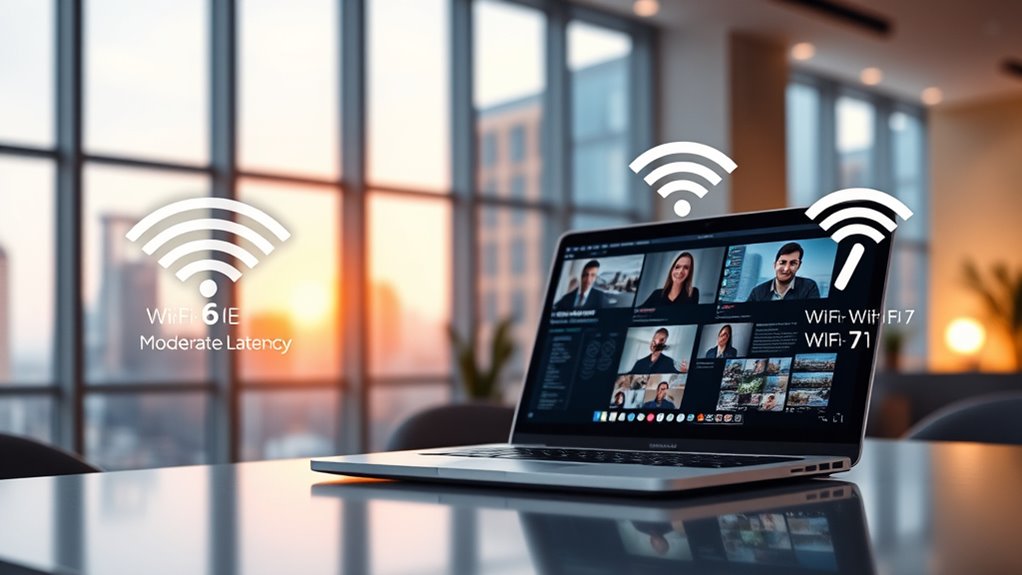
Advancements in wireless technology have considerably improved real-time application performance by reducing latency and boosting network responsiveness. With Wi-Fi 7, you’ll experience lower latency thanks to smarter scheduling, advanced spectrum management, and Multi-Link Operation (MLO), which allows simultaneous connections across bands. This means less waiting time and smoother data flow, especially in high-demand environments. Here’s what Wi-Fi 7 offers:
- Reduced latency through enhanced scheduling and MLO.
- Better prioritization for latency-sensitive tasks like gaming and video calls.
- Increased spatial streams for multiple real-time connections.
- Improved throughput via dense data packing with 4K-QAM modulation.
- The technology’s effectiveness is especially pronounced in crowded settings, where Wi-Fi 7 maintains low latency despite high device density.
Compatibility and Device Ecosystem
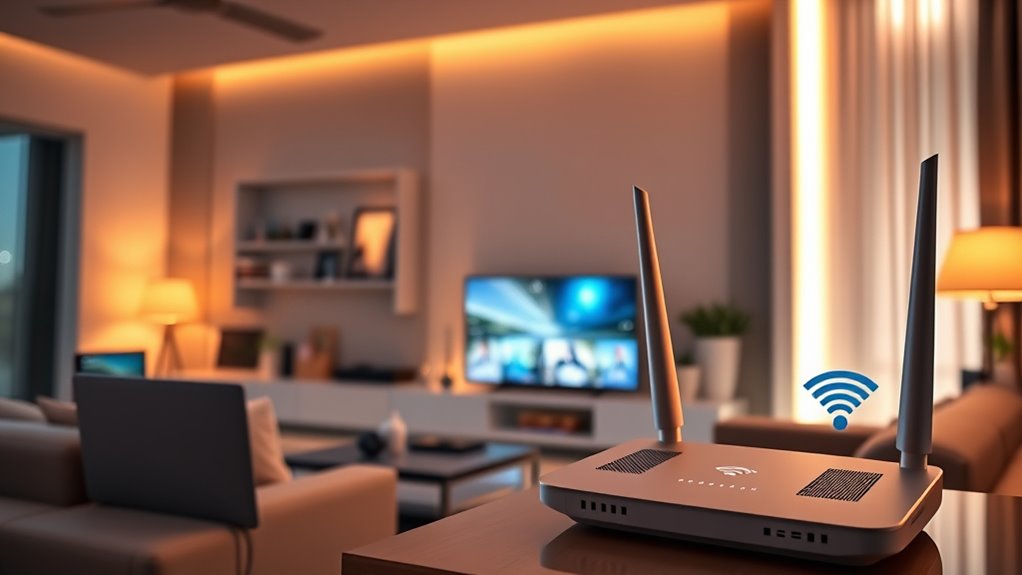
Wi-Fi 7 is designed to be backward compatible with all previous Wi-Fi standards, including Wi-Fi 6E and earlier versions. This means your existing Wi-Fi 6E devices will connect seamlessly to Wi-Fi 7 routers, but they won’t reach Wi-Fi 7’s maximum speeds or enjoy its advanced features. Compatibility supports legacy bands like 2.4GHz and 5GHz, along with the new 6GHz band used by Wi-Fi 6E and 7. Since Wi-Fi 6E devices have been around since 2020, the ecosystem is more mature, whereas Wi-Fi 7 devices are still emerging. Most available client devices supporting Wi-Fi 7 tend to be high-end or newer models, mainly targeting enterprise or early adopters. Overall, the existing device ecosystem influences how soon you can fully benefit from Wi-Fi 7’s capabilities.
Practical Benefits for Different Environments
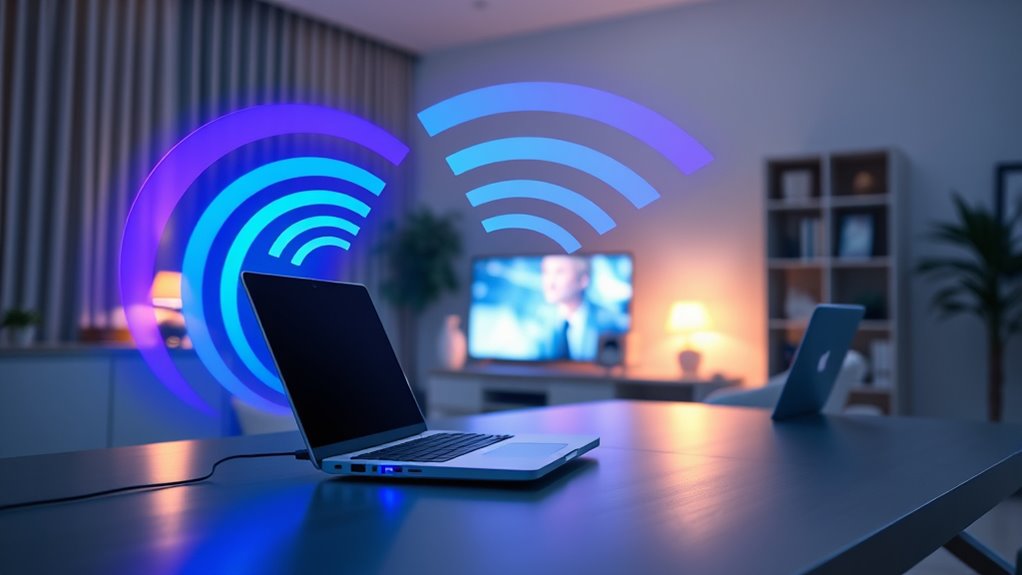
The practical benefits of Wi-Fi 7 become especially clear when considering different environments, from home networks to dense urban areas and high-bandwidth activities. In homes, you’ll notice faster speeds, lower latency, and better spectrum management, making online gaming and streaming smoother. In dense urban areas, Wi-Fi 7 reduces interference, increases capacity, and maintains stable connections despite crowded networks. For high-bandwidth activities, it handles 8K streaming, VR, AR, and large data transfers effortlessly, minimizing lag. In business settings, you get enhanced collaboration, higher device capacity, prioritized tasks, and improved security. Additionally, Wi-Fi 7’s advanced features support network resilience by adapting quickly to changing conditions, ensuring consistent performance even during peak usage times. Enhanced bandwidth management allows for more efficient distribution of resources, which is crucial in high-demand scenarios. Moreover, Wi-Fi 7’s ability to support multiple simultaneous connections ensures that numerous devices can operate efficiently without sacrificing performance. Furthermore, its advanced modulation techniques contribute to better overall efficiency and link quality across various environments. This technology also facilitates future-proofing of networks, allowing seamless integration of upcoming high-bandwidth applications and devices.
Making the Right Choice: Is an Upgrade Necessary?
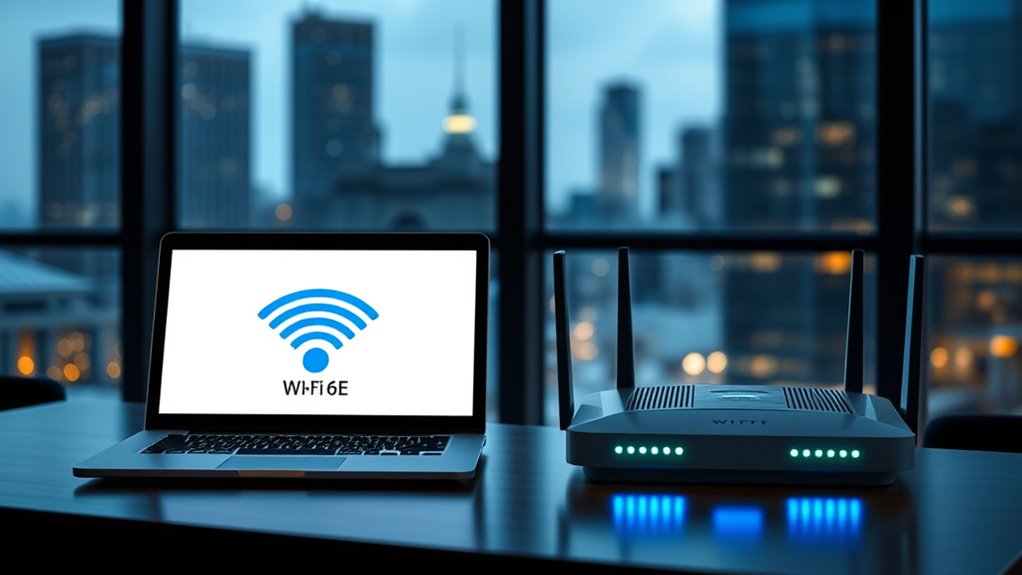
Deciding whether to upgrade your wireless network depends largely on your current device compatibility and how you use your internet connection. If your devices are primarily Wi-Fi 6, upgrading to Wi-Fi 6E offers noticeable improvements without significant cost. However, Wi-Fi 7 requires compatible devices, which will take years to become widespread. For now, holding off on Wi-Fi 7 makes sense unless you need the highest speeds or lowest latency for demanding tasks like gaming or high-bandwidth applications. Wi-Fi 6E hardware is affordable and readily available, making it a practical upgrade. Consider your network needs, device ecosystem, and budget. If you’re satisfied with your current setup and don’t require cutting-edge performance, waiting for Wi-Fi 7’s broader adoption is a smart move. Additionally, understanding wireless standards can help you make an informed decision about your upgrade, especially as newer wireless technologies continue to evolve. Exploring network compatibility can further ensure your devices will perform optimally with your chosen upgrade, and staying informed about security features is increasingly important as networks become more advanced. Moreover, staying aware of tuning options for your network can help optimize performance and reliability over time.
Frequently Asked Questions
Will Wi-Fi 7 Devices Be Compatible With Existing Wi-Fi 6E Routers?
You wonder if Wi-Fi 7 devices work with existing Wi-Fi 6E routers. The good news is, they’re compatible and will connect seamlessly using Wi-Fi 6E protocols. However, you won’t get the full benefits like higher speeds, lower latency, or advanced features unless you upgrade your router. For now, Wi-Fi 7 devices perform well on 6E networks, but to access their full potential, a Wi-Fi 7 router is the way to go.
How Much More Expensive Are Wi-Fi 7 Routers Compared to Wi-Fi 6E?
You wonder how much more Wi-Fi 7 routers cost compared to Wi-Fi 6E. Generally, Wi-Fi 7 models are pricier because they include advanced features, faster speeds, and better support for multiple devices. Entry-level Wi-Fi 7 routers can be somewhat affordable, but high-end models may cost markedly more—sometimes double or even triple the price of typical Wi-Fi 6E routers. The extra expense reflects the improved performance and future-proofing Wi-Fi 7 offers.
Is Wi-Fi 7 Necessary for Streaming 4K or 8K Content at Home?
If you’re streaming 4K or 8K content at home, Wi-Fi 7 offers significant benefits. Its higher speeds and lower latency ensure smooth playback without buffering, even with multiple devices. While Wi-Fi 6E can handle 4K streams well, Wi-Fi 7 provides extra capacity and future-proofing for growing smart home and entertainment needs. Consider your current setup and future plans to determine if the upgrade is worth it for your high-resolution streaming.
Can Wi-Fi 6E Handle the Increasing Number of Smart Home Devices?
Sure, Wi-Fi 6E handles your growing smart home gadget obsession like a champ. With its increased capacity and support for multiple devices, it reduces interference and keeps your smart lights, security cameras, and voice assistants working smoothly. You won’t need to worry about lag or dropped connections, even with a house full of smart devices. It’s future-proofing your network, making sure your smart home keeps humming without a hitch.
When Will Wi-Fi 7 Become Widely Available for Consumers?
You’re wondering when Wi-Fi 7 will be widely available. Currently, early adopters can access it since October 2023, with the official release expected in spring 2024. As more devices support Wi-Fi 7, market penetration will grow rapidly, reaching over 2.1 billion devices by 2028. Expect mainstream availability within a year or two after the official launch, as manufacturers ramp up production and consumer adoption increases.
Conclusion
So, should you upgrade to Wi-Fi 7 or stick with Wi-Fi 6E? Think of it like choosing between a sports car and a reliable sedan—you’ll get more speed and power with Wi-Fi 7, but Wi-Fi 6E still covers most needs. If you crave lightning-fast streams and future-proofing, the upgrade feels like a no-brainer. Otherwise, your current setup might just be enough—after all, sometimes, the grass isn’t always greener on the faster side.
